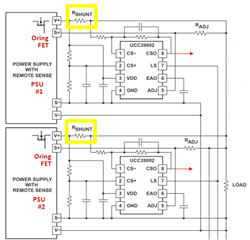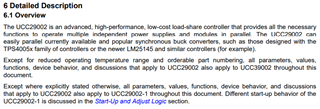Other Parts Discussed in Thread: UCC29002,
Tool/software:
Hello,
My customer is looking for a load share controller for a PSU that supports the outputs below.
- VOUT & IOUT = 12V/8A, 50V/24A dual output
Q1. We can't find any of TI's load share ICs that support 50V. Are there any application notes or reference designs to support PSU 50V output with TI's load share IC?
If there is a suitable product for load sharing of the above PSU outputs, please recommend it.
Q2. They plan to load share after separating PSU1 and 2 with ORING FET. Is it correct to configure it as shown in the example picture below?
Q3. Is it possible to monitor the current in each channel using the output voltage of IC pin 8 to detect the current in Rshunt?

Thank you.
JH


